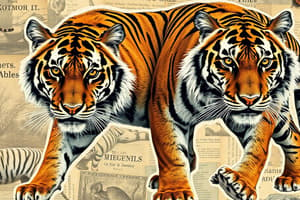Podcast
Questions and Answers
What is the most significant implication of Boris and Svetlaya's successful reunion and mating for Amur tiger conservation strategies?
What is the most significant implication of Boris and Svetlaya's successful reunion and mating for Amur tiger conservation strategies?
- It confirms the necessity of continuous human intervention in the mating process of rescued tigers.
- It demonstrates the limited viability of conservation centers in preparing tigers for life in the wild.
- It suggests that releasing unrelated, rescued tigers into separate areas can lead to successful population restoration. (correct)
- It highlights the importance of providing supplementary food sources after releasing tigers to ensure their initial survival
Why might the conservation center have chosen to release Boris and Svetlaya in separate locations more than 100 miles apart?
Why might the conservation center have chosen to release Boris and Svetlaya in separate locations more than 100 miles apart?
- To ensure minimal competition between the two tigers for resources, thus maximizing individual survival rates.
- To study the effects of geographical separation on the tigers' social behavior before allowing them to interact.
- To test the tigers' ability to adapt to different environments and prey availability.
- To encourage the tigers to establish territories independently and potentially expand the species' distribution. (correct)
Considering the Amur tiger's habitat and behavior, which factor presents the greatest ongoing challenge to their long-term survival, despite increased numbers?
Considering the Amur tiger's habitat and behavior, which factor presents the greatest ongoing challenge to their long-term survival, despite increased numbers?
- The genetic consequences of a small population size, leading to reduced genetic diversity. (correct)
- The risk of disease outbreaks due to increased interaction among tiger populations
- The natural fluctuations in temperature extremes, impacting their hunting efficiency.
- The competition with other predator species for limited prey within their territory.
How does the success of Zolushka, the rescued tiger, contribute to the broader understanding of Amur tiger conservation?
How does the success of Zolushka, the rescued tiger, contribute to the broader understanding of Amur tiger conservation?
What critical adjustment to the rehabilitation process might further improve the success rate of released Amur tigers, based on the information provided?
What critical adjustment to the rehabilitation process might further improve the success rate of released Amur tigers, based on the information provided?
Given that Amur tigers require large hunting areas and their population remains endangered, what is the most likely limiting factor to their continued population growth?
Given that Amur tigers require large hunting areas and their population remains endangered, what is the most likely limiting factor to their continued population growth?
Considering the Amur tiger's adaptation to extremely cold environments, which physiological trait is most crucial for their survival in these conditions?
Considering the Amur tiger's adaptation to extremely cold environments, which physiological trait is most crucial for their survival in these conditions?
How might the success of Amur tiger conservation efforts influence strategies for conserving other endangered large predator species worldwide?
How might the success of Amur tiger conservation efforts influence strategies for conserving other endangered large predator species worldwide?
If conservation efforts lead to a significant increase in the Amur tiger population, what secondary ecological effect is most likely to occur?
If conservation efforts lead to a significant increase in the Amur tiger population, what secondary ecological effect is most likely to occur?
Considering the history of Amur tigers being on the brink of extinction due to poaching and habitat loss, what is the most proactive long-term strategy to ensure their survival?
Considering the history of Amur tigers being on the brink of extinction due to poaching and habitat loss, what is the most proactive long-term strategy to ensure their survival?
Flashcards
Boris and Svetlaya
Boris and Svetlaya
A pair of rescued Amur tigers in Siberia, Russia, who reunited and mated after being separated.
Rehabilitation approach
Rehabilitation approach
Raising orphaned animal cubs with minimal human contact in an environment resembling the wild to develop their natural hunting instincts.
Conservation strategy
Conservation strategy
Releasing rescued tigers in separate areas to expand the population of the endangered species.
Wildlife Conservation Society (WCS)
Wildlife Conservation Society (WCS)
Signup and view all the flashcards
Zolushka ("Cinderella")
Zolushka ("Cinderella")
Signup and view all the flashcards
Amur tigers
Amur tigers
Signup and view all the flashcards
Poaching and habitat loss
Poaching and habitat loss
Signup and view all the flashcards
Study Notes
- Boris and Svetlaya, two rescued Amur tigers, reunited as mates in Siberia after being separated for over a year across a distance of 100 miles.
Background
- In 2014, Boris and Svetlaya, unrelated orphaned cubs aged 3-5 months, were brought to a conservation center in Siberia.
- They were raised with minimal human contact in an environment that mimicked the wild.
- To develop hunting instincts, the tigers were given live prey like rabbits and pheasants.
- At 18 months old, they were released into separate areas in the Sikhote-Alin mountains, over 100 miles apart.
- The separation aimed to spread the endangered tiger population across a wider area.
Reunion
- Wildlife Conservation Society (WCF) researchers monitored Boris and Svetlaya.
- A year post-release, Boris traveled north in a straight line towards Svetlaya's location.
- The tigers reunited, and six months later, Svetlaya had a litter of cubs.
- The findings were published in the Journal of Wildlife Management in November 2024.
- Using rescued cats to restore tiger populations in the wild had not been attempted before.
- Boris and Svetlaya’s success could make the rescue strategy a viable option.
Other Tigers
- Another rescued tiger named Zolushka was released into the wild and paired with a wild tiger; they also had cubs.
- Dale Miquelle of the WCS referred to it as “Cinderella’s prince showed up, and they lived happily ever after."
Amur Tigers
- Amur tigers, also known as Siberian tigers, are the largest tiger subspecies.
- They are native to eastern Russia and parts of China.
- They have thick, pale orange coats with dark stripes.
- The tigers camouflage well in snowy landscapes and tolerate temperatures as low as -50°F (-46°C).
- As solitary hunters, they require large areas to search for prey like deer and wild boar.
- Due to poaching and habitat loss, Amur tigers were once close to extinction, but conservation efforts have increased their numbers to about 500 in the wild.
- While still endangered, renewed hope exists for the species' preservation.
Studying That Suits You
Use AI to generate personalized quizzes and flashcards to suit your learning preferences.





